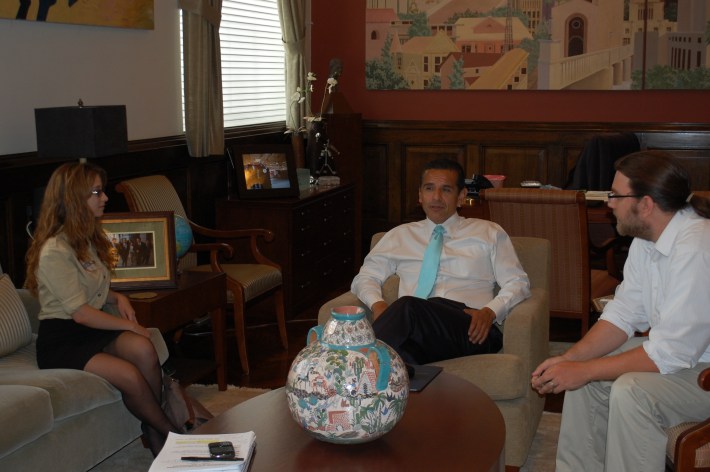The Mayor began our interview talking about a college student’s commute from Downtown Los Angeles to California State University Northridge. The student leaves home early in the morning on a bike. He soon hops on the Metro Red Line to North Hollywood. In North Hollywood, he transfers to the Orange Line. When he gets off the bus, he finishes his trip on bicycle. In the evening, he does the same commute in reverse.
His father, an ardent environmentalist, sometimes argues with his son to take the car. Like many parents, he worries about all the bicycling on Los Angeles’ sometimes-dangerous streets, especially at night. The son always gives a variation of the same reply:
"Dad, you're really great on climate change and transportation,” he responds. “Our generations are the first to really think about climate change. But the difference between your generation and my generation is that we don't just think about it, we live it."
The father in the story is, of course, Antonio Villaraigosa.
Mayor Villaraigosa’s anecdote wasn’t just a great way to start what turned out to be a long and animated interview, which took place on Thursday, July 12th. The story also highlights one of the most vexing problems he’s faced as mayor of the city of Los Angeles: How does a mayor help lead a city away from its reliance on the automobile when the culture of the single-passenger car is so ingrained in Los Angeles?
"You go to the great cities around the world, and you see they’re not just addicted to the car,” the mayor supplies. “You see people walking, which is why they're thinner, you see people getting on buses and light rail.”
But getting Los Angeles from where it was at the turn of the century to where it is today -- and to where the mayor wants to see it in the future -- was and is quite a lift. Especially when faced with a skeptical public and a court that places form over function.
“On bike lanes, they’re telling me I have to do a CEQA (California Environmental Quality Act environmental review) process on bike lanes?” he asked rhetorically. “That’s why you can’t build anything here. Whenever you try to build something it’s World War XVI.”Environmental reviews -- and the lawsuits they can spawn -- have been a constant thorn in the side of the mayor who blames a political left wing for enabling a system where the environmental process slows or even stops small projects that could make a positive environmental difference.
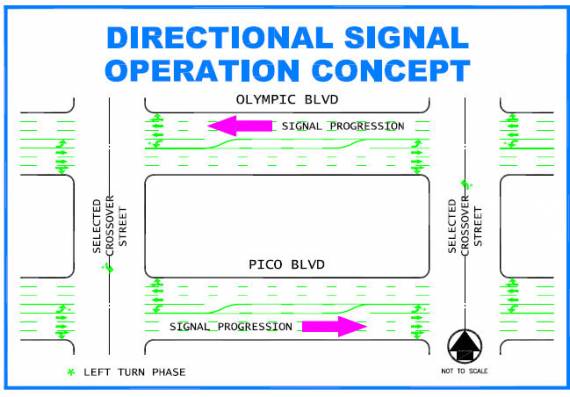
When preparing for the interview, one theme Streetsblog developed was “how does a mayor get from promoting a project such as the Pico-Olympic Plan in -- which would have helped cars speed to and from the Westside in 2007 -- to the South Figueroa Corridor Project, which is all about increasing the dedicated space for bicycles and pedestrians?”
The mayor firmly rejected the premise, arguing that the city transportation initiatives that defined his first term as mayor were necessary, both as transportation projects and public relations pieces needed to rally the public for larger initiatives.
"It's really hard to get a public that's so committed to the single passenger automobile off of that. So you have to do both. I did Pico-Olympic. I did the Tiger Teams. I did stop construction. I knew if I didn't do that stuff everybody would say (of the transit expansion, especially the Subway to the Sea,) ‘Oh, that's pie in the sky. You don't know what you're talking about.’ I had to do all of it."
In 2001, during his first, ultimately unsuccessful, run for mayor, Villaraigosa pushed the idea of creating a city-wide rail transit system, but the public wasn’t ready.
"People didn't want to hear it. They didn't think it was possible.” he said. “They wanted to hear the small things."
Given a second chance in 2005, Villaraigosa focused the campaign on both the big and the small. The Subway to the Sea, the colorful name for the Westside Subway, was mixed with other, more modest, proposals. To hear him tell it, Tiger Teams to clear parked cars in travel lanes, a ban on road construction during rush hour and an aggressive traffic signal retiming plan weren’t just about physically moving traffic, they were all about moving people mentally, too.
But of course, not everything went according to plan. The aforementioned Pico-Olympic Plan ran into neighborhood resistance over the removal of peak hour parking. Bill Rosendahl and Paul Koretz, the two local City Council Members representing the west portion of the plan, were in opposition of the project, and in 2008 a judge ruled that the plan needed a full environmental review.
"This is where I criticize the left,” Villaraigosa began, “The courts opined that just to change parking, do re-striping and synchronize lights, a basic ministerial function of any government, we have to do CEQA. That's where the system is broken.”
Just because CEQA is slowing the city’s Bike Plan and other projects doesn’t mean that there was a lack of progress in the last year. The city officially installed 76 miles of new bike infrastructure last year. Even critics, some who dispute a small amount of that total, praise recent bikeway mileage as a huge increase from previous years.
Some point to the mayor’s July 2010 crash -- where a parked taxi pulled into the street and forced Villaraigosa from his bike and sent him crashing to the ground -- as the moment when the administration began to take bike safety and bike infrastructure more seriously. The mayor said the groundwork was laid earlier.
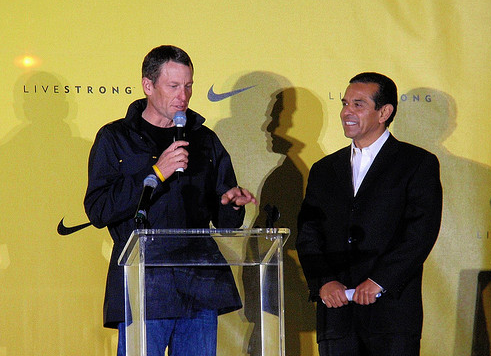
“When I got back from Copenhagen (in December of 2009), I told my staff, ‘hey man, everyone's on a bike, I love it. What's up with the bike stuff that you're working on?” At this point the mayor unveiled a voice he apparently uses to imitate city staff when they’re not working at a pace he would like. The voice sounded somewhere between Huckleberry Hound and Eeyore. “They were like, 'it's in committee…' Man, we need to work on this.”
“Then we went to Mexico City and they closed down this whole long street mile after mile after mile. (For Mexico City’s Ciclovia) And everyone was on bikes. When I told staff ‘I want to do that.’ They were like, ‘well we're working on CicLAvia.’ You told me that eight months ago. 'well, it's really expensive and we don't have the money, each one costs $250,000.’
I said what about the private sector, what about philanthropy…’well...ok...’”
It wasn’t until after the mayor’s elbow was shattered in the aforementioned crash that city staff understood how important an issue bicycle safety was. Calling it a “teachable moment,” Villaraigosa used the crash as a “call to arms.” Using the energy of the existing bicycle advocacy community, the mayor called a Bike Summit in the summer of 2010, which doubled as an exercise to show the Eeyores of city staff that it was past time to get moving.
Quickly following the August 2010 Bike Summit was the first CicLAvia, followed by the battle and passage of the “surprisingly progressive” bike plan. Less than a year after the crash, the city was working on a record number of bike projects, had created a dedicated fund for bicycle projects from Measure R, had appointed Jaime De La Vega to replace lifetime city staffer Rita Robinson as head of the city’s Department of Transportation, and was bringing in a team of bicycle design experts from the Netherlands for a “design charrette” to empower the vision of city planners.
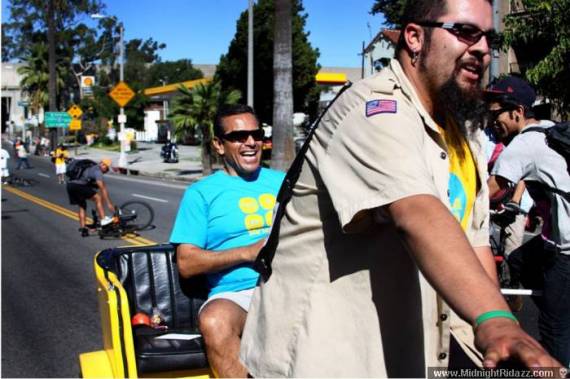
The year after that saw roughly 76 miles of new bike infrastructure. The Spring Street Green Buffered Bike Lane and the Main Street Buffered Bike Lane have formed the backbone of an emerging downtown Los Angeles bike network, and the Boyle Heights’ First Street Green Bike Lane and the Main Street road diet in Venice were both welcome additions. Nobody is ready to declare Los Angeles a bicycling paradise, and many cyclists remain frustrated when comparing L.A. to Long Beach, but progress is being made.
Not to say everyone is excited. The mayor noted that many media outlets praised the bike plan’s passage, but still jumped on the projects in the plan during their implementation. The most notable example of this is the Spring Street Green Buffered Bike Lane, arguably the most progressive bike infrastructure in the city, which was panned repeatedly by the Los Angeles Times, both in their news and editorial sections.
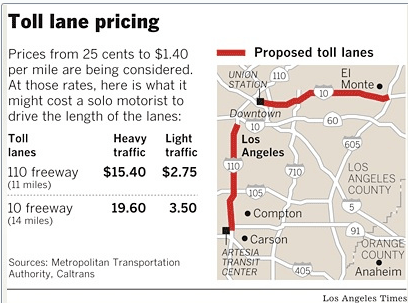
Another area where the media has not been kind to the mayor is congestion pricing. In 2008, Metro received a grant from the U.S. Department of Transportation to try an experimental pilot program by converting to High Occupancy Vehicle lanes to High Occupancy Toll lanes. Congestion pricing in various forms has been tried across the world and has uniformly shown reduction in congestion in all lanes, HOT and regular mixed-use.
At no point during the interview did Villaraigosa show more enthusiasm than when discussing congestion pricing and the political battles needed to get the approval of the Metro Board of Directors.
“When I saw that New York and San Francisco lost out on congestion pricing dollars, I went to (USDOT Secretary) Mary Peters and said ‘I want the money.’ She said ‘You'll never get it past your legislature.’ I said, ‘Watch me.’ She said you'll never get it past your board.”
Despite the track record of congestion pricing, Metro’s plan received bi-partisan condemnation. “Democrats were against it because [they said] it hurts poor people. Republicans were against it because they said freeways are free--you're taxing it twice.”
Things became so ugly that Metro had to change which freeways would receive the HOT Lanes. At first, the plan called for the I-10 and I-210 to receive the HOT Lane treatment. After San Gabriel Valley politicians, led by County Supervisor/Metro Board Member Gloria Molina, State Senator Gloria Romero and a bipartisan team of congress members, completely flipped out, plans for the I-210 were scrapped and the I-110 south of Downtown Los Angeles was added to the plan.
Villaraigosa explains. “I came up with the notion that we're going to get this through. We had virtually all the congressional delegation against it, so what did we do? We got more buses. We started on the 110 because the 10 went into other cities and we went into other cities and we had more control in my own city.”
Overall, the federal government paid $213 million for the congestion pricing pilot program, most of which are going to expanded bus service and stations.
If the lanes on the I-10 and I-110 are a success, Angelenos can expect more congestion pricing in the coming years. “The goal is to have one day have congestion pricing. Studies show that it reduces congestion…but it's a hard sell to people."
Metro is currently studying five other corridors for congestion pricing.
Tomorrow, Streetsblog will post “The Subway Mayor Triumphant,” part two of the mayor’s interview, with topics including transit, transit expansion, Measure R and Measure R+.
(Note: This story was also copy-edited by Joe Linton and Carter Rubin.)
